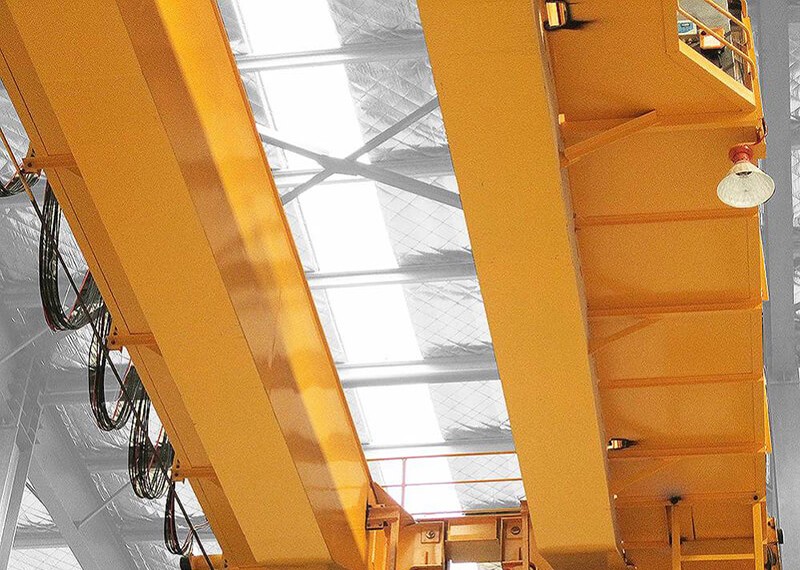
Crane design knowledge
A crane uses hooks or other grabbing devices to suspend heavy objects, and is a machine that performs cyclic operations such as lifting and transportation in space. Hoisting machinery: refers to electromechanical equipment used for vertical lifting or vertical lifting and horizontal movement of heavy objects. Its scope is defined as a crane with a rated lifting capacity of 0.5t or more and a lifting height of more than 1t and a lifting height of 2m or more. , Electric hoist with fixed support, etc.
Working characteristics Intermittent motion means that in one or several operating cycles of the crane, each mechanism has a pause time, and not all mechanisms are in continuous operation.
Working cycle The working cycle of a crane is the complete process from lifting the object to the next lifting, including the normal operation and stopping of the crane.
There are many types of heavy objects lifted by variable load cranes, some weighing hundreds of tons or even thousands of tons, and some are tens of meters long and have irregular shapes, such as loose particles, hot melt state, inflammable and explosive dangerous goods, etc.
Classification of cranes.
There are many classification methods for cranes, which are classified according to their main uses and structural characteristics.
There are general-purpose cranes, construction cranes, metallurgical cranes, railway cranes, port cranes, deck cranes, etc.
According to the structural characteristics, they are divided into bridge cranes, cantilever cranes and cable cranes; rotating cranes and non-rotating cranes; fixed cranes and running cranes are divided into track type (running on a fixed track) and non-track type (running on a fixed track). Tire or track support).
Introduction to common cranes.
1. General purpose bridge crane.
General-purpose bridge cranes: mainly include hook cranes, grab cranes, electromagnetic bridge cranes, dual-purpose bridge cranes and three-purpose bridge cranes. Bridge cranes are widely used in indoor and outdoor warehouses, factories, docks and open-air storage yards.
A general-purpose bridge crane is generally composed of a metal structure (bridge and cart frame), a lifting mechanism, a cart running mechanism, a cart running mechanism and electrical equipment. The lifting mechanism is used to lift items vertically, and the lifting vehicle is used to move laterally with a load. The operating mechanism of bridges and large vehicles is used to move vertically with lifting vehicles and objects, and to move and load and unload goods in a three-dimensional space composed of spans and designated heights.
The hook bridge crane is composed of a metal structure, a large vehicle operating mechanism, a small vehicle operating mechanism, a lifting mechanism, electrical equipment and control systems, and a cab. The fetcher is a hook. Most of the rated crane structures below 10T are above 16T, mainly including main hooks and auxiliary hooks. The weight of the secondary hook is about 1/5-1/3 of the main hook, but the secondary hook is faster than the main hook. It can load and unload, transport materials and equipment in various working environments. It is suitable for hoisting operations in mechanical processing and assembly workshops, metal structure workshops, mechanical maintenance workshops, various warehouses, and metallurgical casting workshops.
The structure of the two-car hook bridge crane is basically the same as the hook bridge crane, and only two identical cranes are installed on the bridge. Cranes are used to lift and load long objects, such as pipes and steel bars.
The structure of the grab bridge crane is basically the same as that of the hook bridge crane, but the crane structure is different. The spreader of the grab bridge crane is a grab, which is suspended on the opening and closing mechanism and the lifting mechanism through four steel wire ropes. Mainly used for loading, unloading and hoisting of bulk, scrap steel and wood.
The basic structure of an electromagnetic bridge crane is the same as that of a hook bridge crane, but the difference is that a DC lifting electromagnet (also called an electromagnetic chuck) is hung on the hook, which is used to lift magnetically conductive ferrous metals and their products. Electromagnetic bridge cranes usually convert AC power to DC power through a motor generator set on the bridge and a thyristor DC box installed in the cab. The DC power is delivered to the crane through a special cable reel on the frame. Electromagnet.
Dual-purpose bridge crane
There are three types of dual-purpose bridge cranes: hook crane, electromagnetic hook crane and hook electromagnetic bridge crane. Its characteristic is that there are two independent lifting mechanisms on the car, one for the grab and one for the hook (or electromagnetic chuck, one for the hook, one for the grab, and one for the electromagnetic chuck), but two lifting mechanisms Institutions cannot be used at the same time.
Three-purpose bridge crane
The three-purpose bridge crane is a multi-purpose crane. Its basic structure is the same as the electromagnetic bridge crane. According to needs, you can use hooks to lift heavy objects, or use hydraulic grabs to load and unload materials. After removing the grab, you can use an electromagnetic chuck to lift the magnetically conductive ferrous metal. The hydraulic grab is powered by AC and DC power sources. Therefore, this type of crane must be equipped with a motor generator set or a thyristor DC power box, just like an electromagnetic bridge crane. The crane is suitable for materials where equipment is frequently replaced.
2. Power station bridge crane
The basic structure of the power station bridge crane is the same as that of the hook crane, but the performance requirements are relatively high, the positioning is accurate, the operation is stable, and it is safe and reliable. It is suitable for the installation and maintenance of generator sets and auxiliary equipment.
3. Explosion-proof bridge crane.
The structure of the crane is basically the same as that of the hook bridge crane. only the whole set of electrical appliances used has explosion-proof performance. The traveling wheels in contact with the track should be made of materials that are not easy to generate frictional sparks to prevent spark explosions or burning accidents during the use of the crane. Mainly used in workshops, warehouses or other flammable and explosive materials.
Cranes
Mine explosion-proof cranes (except coal mines) are classified into first and second levels according to the use environment, and explosion-proof cranes used in factories are classified as first class.
Class Ⅱ cranes are classified into three levels a, b, and c according to the maximum test safety gap and minimum ignition current ratio of electrical equipment suitable for explosive gas mixtures, and are divided into groups T1-T44 according to the highest surface temperature.
4. Insulated bridge crane
The structure of the crane is basically the same as that of an ordinary hook bridge crane. Just to prevent the current of live equipment from being transmitted to the crane through the crane, endangering the safety of the driver, it is necessary to install three insulating devices on the hook group, the frame, and the wheels (or under the track). Mainly used in aluminum and magnesium refineries.
5. metallurgical bridge crane
According to different uses, metallurgical bridge cranes can be divided into different types (loading machine, container machine, casting machine, pay-off machine, clamping machine, uncovering machine, forging machine and quenching machine). The main structure is basically the same as that of the hook bridge crane, and the retrieval device is mostly dedicated. Mainly used for lifting operations in metallurgical workshops, with a large lifting capacity, up to several hundred tons.
6. Fixed bridge crane
Bridge erecting machine is a device that puts prefabricated beams on prefabricated piers. Its main function is to lift the beam, and then transport it to an appropriate location and put it down. Bridge erecting machines can be divided into several types such as highway bridges, conventional railway bridges, and passenger railway bridges.
7. Electric single beam crane
The electric hoist cart runs on the lower flange of the main beam and is installed on the bridge crane below the main beam. It is mainly used for lifting goods in different occasions such as factories and warehouses.
8. Electric single beam suspension crane
It is mainly composed of electric hoist, metal structure, large-scale automobile operating mechanism, feeding device and electrical device. Its advantages are small size, small headroom, light weight and small wheel pressure. It is widely used for goods in factories, warehouses, storage yards and other different occasions.
9. Electric crane
Electric hoist cranes use fixed electric hoists as the crane mechanism, and the transmission devices of automobile operation and large-scale automobile operation are also summarized with electric hoist components as much as possible. Compared with the above-mentioned general bridge cranes, the electric hoist is light in weight, low in energy consumption, easy to match with the standard electric hoist, the site pressure load is small, and the construction and use economy are more and more widely used in general occasions with small and medium hoisting ranges.
10. Explosion-proof beam crane
only the whole set of electrical appliances used has explosion-proof performance. The traveling wheels in contact with the track should be made of materials that are not easy to generate frictional sparks to prevent sparks from exploding or burning during the use of the crane. Simple structure, small size, light weight, easy to install, use and maintain. Mainly used in workshops, warehouses or other flammable and explosive materials.


